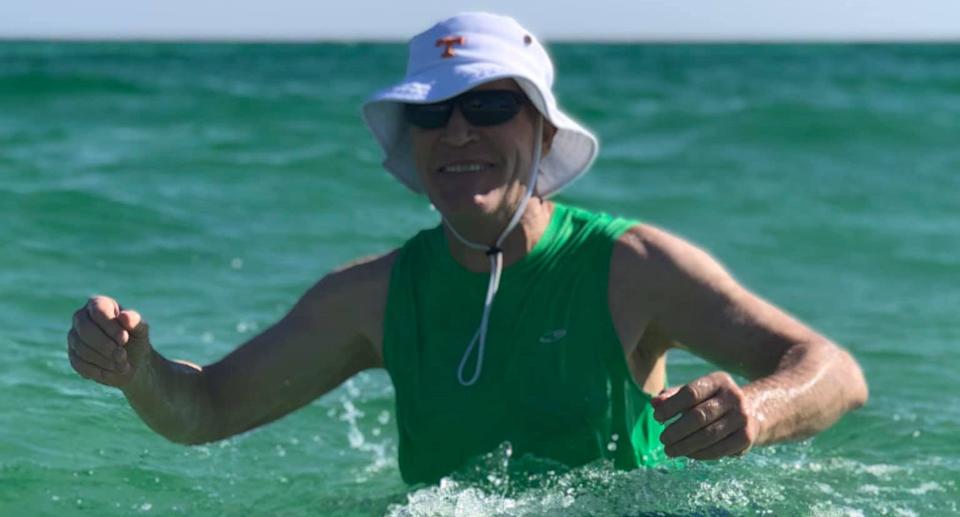What the Health?! Can you contract flesh-eating bacteria from swimming? What you need to know

Can leftover spaghetti really kill you? Can you actually cough up a blood clot in the shape of your lung? In Yahoo Lifestyle Canada‘s newest series, What The Health?!, we ask doctors to weigh in on odd health news stories and set the record straight. Be sure to check back every Friday for the latest.
A Florida woman mourning the death of her father is warning people about the risk of contracting flesh-eating disease bacteria from swimming in various waterways—including rivers, lakes, bayous, and the ocean.
Cheryl Bennett Wiygul shared news of her dad’s tragic passing in a Facebook post that has gone viral: “Flesh-eating bacteria sounds like an urban legend. Let me assure you that it is not. It took my Dad's life,” she wrote. “Less than 48 hours after getting out of the water feeling great, the bacteria had destroyed him.”
Bennett Wiygul’s father, 66-year-old Dave Bennett of Memphis, Tenn., had a weakened immune system due to cancer. Lab tests confirmed that he had acquired Vibrio vulnificus, a type of bacteria that can lead to necrotizing fasciitis, the medical term for flesh-eating disease.

The family had gone swimming at Destin Beach, Turkey Creek, Boggy Bayou, and Rocky Bayou. Twelve hours after being in the water, Bennett woke up with a fever, chills, and some cramping. Within hours, his legs started to hurt severely. In hospital, his wife noticed a swollen black spot on his back that began to get bigger, and another one starting to appear. “His arms were becoming more blotchy by the minute and he was in a great deal of pain,” Bennett Wiygul wrote, adding that her father had become septic.
Bennett’s passing is just one of several recent fatal cases associated with flesh-eating disease.
Also in Florida, a 77-year-old woman in named Carolyn “Lynn” Fleming died two weeks after developing a small cut at Coquina Beach. Her leg became painful, red, and swollen, before later turning black. Two surgeries to remove the dead tissue weren’t enough to prevent the disease from spreading throughout her body.
A Virginia woman, meanwhile, contracted a flesh-eating infection caused by Group A streptococcus bacteria after spending just 10 minutes in the water at Norfolk’s Ocean View Beach. The next day, she didn’t fell well and noticed a spot on her leg. She ignored it at first, but after a few days, it started to get bigger and more painful, to the point where she couldn’t walk. She had to have emergency surgery to drain the wound and was prescribed antibiotics.
Flesh-eating disease arising from the staphylococcus organism, also known as Group A strep, is more commonly seen in Canada, says Michael Silverman, division chair and chief of infectious diseases at Western University in London, Ontario. The same organism that causes sore throat can enter the body through small, traumatic injuries to the skin and lead to invasive infection and necrotizing fasciitis.
ALSO SEE: A tick lodged in man's eye and had to be pried off, making a 'little popping sound'
Less common is Vibrio vulnificus bacteria, which occur in “brackish” water. That’s semi-salty, semi-fresh water, such as where rivers meet the sea, like those in Florida entering the Gulf of Mexico.
“If you’ve got a cut, especially if you’ve got an immune system problem, the most common one being liver disease—and you’re in that water, it can get under the skin and can cause this severe infection,” Silverman says. “It [flesh-eating disease] can happen in healthy people with no immune deficiency, but it is far more common in people with a compromised immune system.

“It’s urgent, and people who have flesh-eating disease need to get medical care,” he says. “It’s important to realize that the vast majority of time people get a skin infection, it’s not flesh-eating disease, but if people are ill and have a high fever and it’s very severely painful, they do need to get urgent medical attention.”
Other signs of necrotizing fasciitis include blistering skin lesions; a rapid decline in health; watery diarrhea accompanied by stomach cramping, nausea, and vomiting; and dangerously low blood pressure.
ALSO SEE: What The Health?! Man finds shark tooth embedded in his foot from 24 years ago
Besides cuts, the bacteria can enter the body through any break in the skin, such as scrapes, burns, insect bites, puncture wounds, and recent tattoos. People can also get necrotizing fasciitis after an injury that doesn’t break the skin, such as blunt trauma.
Treatment for flesh-eating disease includes antibiotics, intensive care, and, sometimes, amputation to remove infected or dead tissue. One in 3 people who contract necrotizing fasciitis die, even with treatment, according to the Centers for Disease Control and Prevention.

Vibrio bacteria occur naturally in certain coastal waters and exist in higher concentrations between May and October when water temperatures are warmer. However, with climate change, flesh-eating bacteria appears to be moving north.
A study published in the Annals of Internal Medicine found that vibrio vulnificus bacteria prefer salty water with surface temperatures above 13ºC, which in the past has been commonly found in the coastal waters of the southeastern United States and the Gulf of Mexico. But the study links five cases of people infected with the bacteria from the typically much cooler waters of the Delaware Bay, which sits between Delaware and New Jersey.
The bacteria can survive in coastal waters with temperatures as low as 9ºC and as high as 31ºC, according to the Journal of Infectious Diseases.
ALSO SEE: This dermatologist got skin cancer — twice. Here’s what she learned.
Another way of becoming infected with Vibrio vulnificus is by eating raw or undercooked shellfish, especially oysters.
A Korean man had to have his arm amputated after acquiring flesh-eating disease from eating a seafood meal, according to a case report in the New England Journal of Medicine. The 71-year-old man went to the hospital after experiencing two days of fever and excruciating pain in his left hand. His symptoms developed 12 hours after he ate raw seafood.
Silverman has suggestions on how to prevent flesh-eating disease.
“Number one is avoiding undercooked shellfish,” he says. “I only eat oysters if they’re well cooked, not raw—that’s dangerous.
“It’s important not to excessively drink alcohol and use drugs that can give you liver disease,” he adds. “And for people who have open cuts and compromised immune systems, swimming in brackish water is not a good idea.”
Let us know what you think by commenting below and tweeting @YahooStyleCA! Follow us on Twitter and Instagram.


